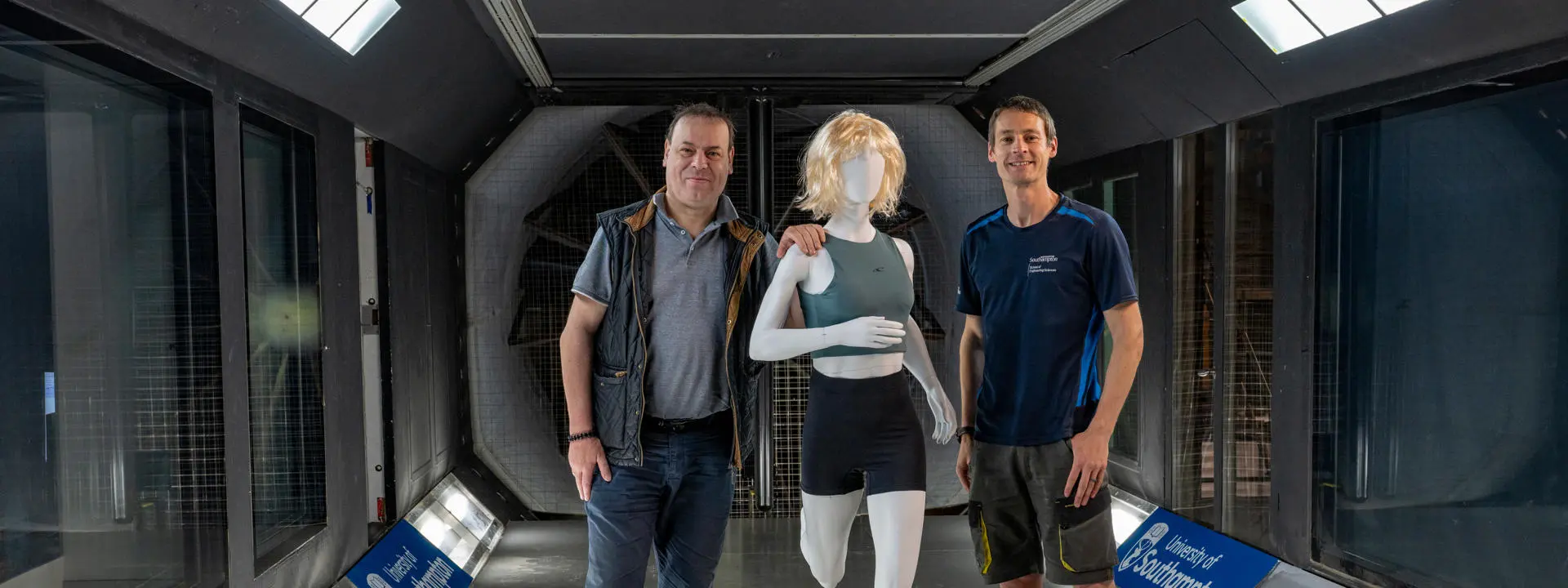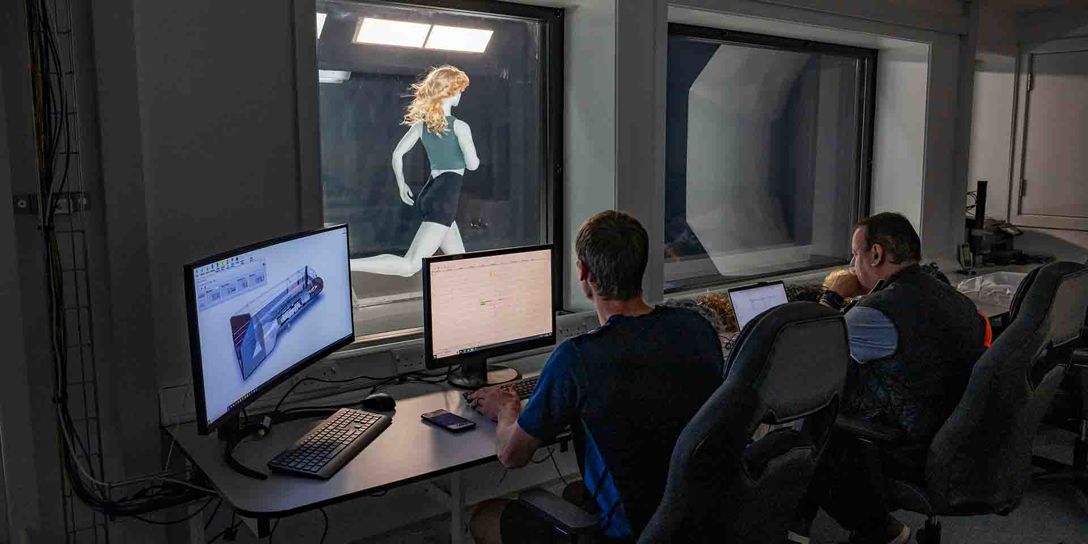Athletes can be significantly slowed down by long hair and loose clothing, new research shows

Long, curly hair and loose clothing can significantly reduce the performance of athletes taking part in long jump and 100 metre sprint events, new research suggests.
In both events, the difference is enough to lose out on a gold medal, the researchers say.
Ahead of the Paris 2024 Olympics, the aerodynamics scientists behind the research suggest the introduction of hair caps and low-drag clothing could be considered in these events, to “level the playing field” in each sport. Hair caps have been used before in athletics on some rare occasions. Athletes’ clothing for all long jump and 100 metre events – for women and men – should also be systematically designed and tested using wind tunnel tests, the researchers recommend.
There’s a surprising misconception that persists up to the present day among some athletes and their coaches that aerodynamic resistance would not be significant in track and field events.
Aerospace engineers at Heriot-Watt University in Edinburgh and KU Leuven university in Belgium, in partnership with American simulation software multinational Ansys, studied the aerodynamics of 10 different hairstyles and 20 different clothing styles in the long jump and 100 metres and concluded that hairstyles and clothing could make the difference between winning or not winning a medal.
The research focused only on women athletes – because male athletes generally have short or shaved hair, the scientists said. But they added that they would expect similar results for male athletes and athletes of other genders.
For long jump athletes, long curly hair and loose-fitting clothing can cut up to 10 centimetres off their jump distance – compared to shorter hair and tight-fitting clothing.
This is enough to lose out on a gold medal, the researchers say.
For 100m sprint athletes, the same long curly hair and loose-fitting clothing combination can cut up to 0.07 seconds off their sprint time – also enough to lose the gold medal to another competitor in the race.
The researchers say theirs is the first-ever published study on the impact of hairstyle and clothing on long jump distance and also the most extensive wind tunnel study to date on the 100m sprint. This is because there’s an incorrect assumption amongst some athletes and coaches in track and field events that hairstyle and clothing in these events have no significant impact on athlete performance.
Aerodynamics expert Professor Bert Blocken, who leads Heriot-Watt University’s aerospace programme at the university’s School of Engineering and Physical Sciences and also advises professional sports teams on aerodynamics at events including the Tour de France, was the initiator and lead author of the study. He said: “There’s a surprising misconception that persists up to the present day among some athletes and their coaches that aerodynamic resistance would not be significant in track and field events. This is compared to faster sports such as cycling, speed skating and skiing – where the impact of clothing and even hairstyle has been firmly established over the past decades. But our research shows this opinion is fundamentally wrong and that hairstyle and clothing can cause significant drag in long jump and 100 metres sprint events. In both events, the impact on performance is enough to lose out on a gold medal.”
The researchers used plastic life-sized mannequins in a wind tunnel, combined with numerical calculations and computer fluid dynamics modelling, to test the different combinations of hairstyle and clothing, as well as 28 different jump postures for the long jump event.

The results showed that long, curly hair can increase athlete drag by up to 8.7% in both the long jump and the 100m sprint. Wearing both a loose-fitting top and loose-fitting shorts also increases drag by more than 23% in the long jump and the 100m sprint, compared to wearing a tight-fitting top and tight-fitting shorts.
“These differences can be decisive in high-stakes sporting events, where a fraction of a second or a centimetre can be the difference between winning or losing out on a medal,” Professor Blocken said.
The research has been published in the Journal of Wind Engineering & Industrial Aerodynamics.
Ansys specialises in engineering simulation software that is used globally to design, test and operate products across multiple industries, including healthcare, transport, energy, construction, sport and the space sector. For the long jump and 100 metres research, the company created digital female mannequins in 28 different postures, to simulate the aerodynamics of different clothing combinations.
Thierry Marchal, Chief Technologist for Healthcare & Sport for Ansys in Europe, the Middle East and Africa, said: “Ansys is proud to partner with Professor Bert Blocken, who has repeatedly demonstrated how simulation can contribute to the safety and performance of the athletes. Our simulation software is used across a wide range of sports to help engineers and athletes make transformational changes to their performance – and was a vital component of this research. Sporting victories are determined by increasingly small margins, and using simulation to improve factors including aerodynamics can provide the competitive advantage to deliver a winning performance.”
The studies are also supported by researchers at another two universities in the United Kingdom – the University of Southampton – who provided their wind tunnel facilities – and the School of Engineering at Oxford Brookes University in Oxford, who provided some of the wind tunnel models. The research was also supported by Belgian mould-making specialist, Tailormold.
Types of hairstyle tested for both the women’s long jump and 100m sprint included long straight hair of different lengths and styles, long curly hair of different lengths and styles and two types of long dreadlocks.
Types of clothing tested for both sporting events included a combination of shorts and shirts in different sizes, styles, materials and surface textures.
“It’s surprising that, even for top athletes, hair caps have almost never been used before in the long jump and 100 metres and that athletics clothing is not systematically tested in wind tunnels,” Professor Blocken said. “This would certainly reduce the athlete’s aerodynamic resistance and level the playing field for them. But Athletics is known to be a rather conservative sport and we wouldn’t expect caps to be introduced any time soon. Even in cycling, the introduction of helmets took many years, and initially the riders even protested.”
Athletes who choose meantime to wear a cap and low-drag clothing that has been designed or verified by wind tunnel testing can “obtain considerable advantages over their competitors,” the researchers said.
Professor Blocken said athletes who have worn hair caps include the US 100 metres sprinter Florence Griffith-Joyner in 1988, who set a new world record for the 100 metres and won three gold medals in that year’s Olympics. Australian sprinter Cathy Freeman also wore an aerodynamic bodysuit for her 400 metre race in the Sydney 2000 Olympic Games, where she won gold.
The long jump is a track and field event in which the athlete sprints down a runway and tries to leap as far as possible from a take-off line. It was already part of the Olympic Games in Ancient Greece and is thought to have been a form of training for warfare, the researchers note. The sport also reflected the crossing of obstacles such as streams and ravines, and required a lot of training and skill from the athlete. The long jump has been part of the modern Olympic Games since 1896, though the women’s long jump wasn’t introduced until 1948.
The 100 metre sprint is one of the most popular and prestigious events in athletics. It has been part of the Olympic Games since 1896 for men and since 1928 for women. A similar discipline existed in the Olympic Games of Ancient Greece, where it was named “stadion.” This name, meaning “stadium” in English, referred to the fact that the athlete had to run the perimeter of the ancient stadium, which was approximately 180m.
This research did not focus on the impact of various types of socks and shoes, but future studies should address potential drag caused by these components, the researchers said.
On braided dreadlock-style hairstyles, Professor Blocken explained that, counterintuitively, while these look like ‘heavier’ hairstyles, during the sprint and the first half of the long jump flight, they tend to be positioned more behind the back of the athlete – so are more sheltered from the wind than loose, curly hair – and more aerodynamic as a result.
The long jump research report, Numerical-physical modelling of the long jump flight of female athletes: impact of jump style, hairstyle and clothing, will be published in the Journal of Wind Engineering & Industrial Aerodynamics.